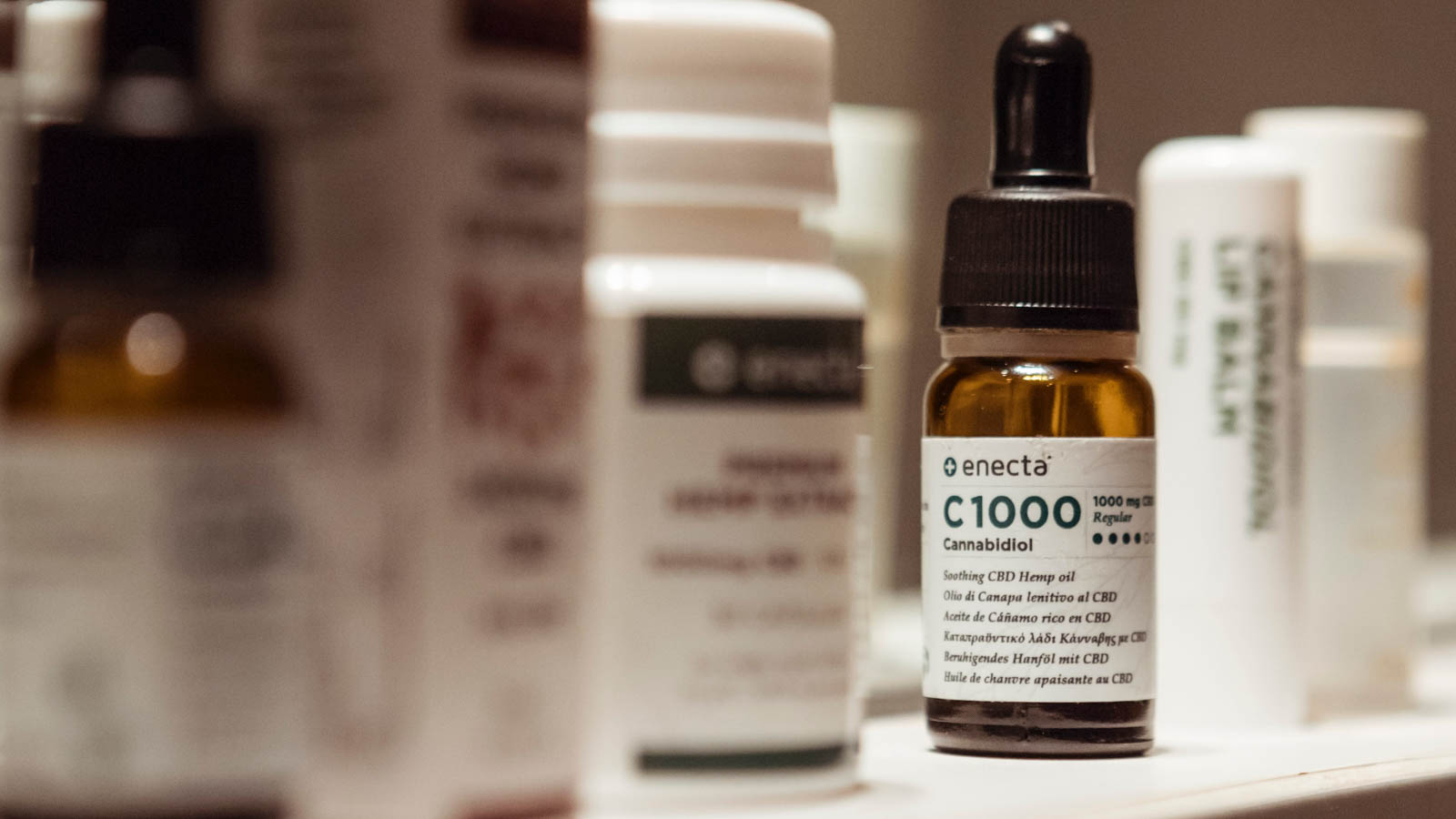
Looking through an assortment of cannabidiol (CBD) products, you might notice certain parts of the label that jump out at you, such as a lively green hemp leaf or the word “organic,” enticing you to give this intriguing product a try. A closer look at that label, however, might raise potential red flags about the quality or accuracy of that CBD product.
In other words, it’s important for consumers to understand how product labeling is regulated when it comes to CBD oil and CBD-infused products.
Even hemp-derived CBD products, which contain little to no THC, were federally illegal until the 2018 Farm Bill passed, legalizing industrial hemp production in the U.S., beginning Jan. 1, 2019. In what seemed like moments, hemp-derived CBD-infused products sprang to life and became the new darlings of the health and wellness industry, even appearing at CVS, Rite Aid, and Walgreens stores.
The Farm Bill made it legal for farmers to grow hemp plants that contain less than 0.3% THC, and shifted oversight from the U.S. Department of Justice (DOJ) to the U.S. Food and Drug Administration (FDA). After the bill was signed, FDA Commissioner Scott Gottlieb issued a statement confirming that the agency would oversee and regulate hemp-derived CBD products under the Federal Food Drug & Cosmetic Act (FD&C Act), a set of laws established in 1938 that gives the FDA authority to oversee the safety of food, drugs, medical devices, and cosmetics.
While the FDA slowly and cautiously approaches making new regulations for CBD products, the gap between regulated products and anything goes grows wider, leaving consumers at risk of buying poor-quality products.
How Does the FDA Regulate CBD Products and Labeling?
The FDA’s website posts 26 common questions and answers about cannabis and hemp, touching on current labeling regulations for CBD products. How a CBD product is labeled and marketed plays a critical role in whether the FDA deems it to be lawful.
“It depends, among other things, on the intended use of the product and how it is labeled and marketed. Even if a CBD product meets the definition of ‘hemp’ under the 2018 Farm Bill, it still must comply with all other applicable laws, including the FD&C Act,” according to FDA site.
The FDA currently does not allow CBD-infused food, drinks, or dietary supplements to be sold, and hasn’t reached a final conclusion on regulating hemp-derived CBD products.
“Currently, the FDA is just asking for information,” said Chris Husong, Vice President of Marketing and Communications at Elixinol, a Colorado-based CBD and hemp extract company. “They’re asking for public guidance and guidelines around that, which we’re happy to give them. Right now, their main instruction is ‘don’t make claims.’ ”
The murkiness surrounding CBD regulations, however, hasn’t stopped the health and wellness industry from putting the spotlight on this non-intoxicating cannabinoid. Wellness companies are following the lead of cosmetic makers, which aren’t bound by the same stringent labeling criteria as drugs, food, or dietary supplements.
The FDA defines cosmetics as “articles intended to be rubbed, poured, sprinkled, or sprayed” on the human body, a description that fits many hemp-derived CBD products. Aside from most color additives, under the FD&C Act, cosmetic products and ingredients are not subject to premarket approval by the FDA – this includes cannabis and cannabis-derived ingredients.
The agency warns that a lack of specific CBD regulations doesn’t grant freedom to make iffy claims. It’s still necessary to comply with the rules that govern safety.
Following the FDA regulations for cosmetic product labeling, CBD-infused health and beauty product labels should:
- Not be false or misleading
- Provide required information (includes identity statement, statement of quantity of contents, name and place of business, distributor statement, material facts, warning or caution statements, and ingredients)
- Properly display label information
- Not violate the Poison Prevention Packaging Act of 1970
Claims About Treating Diseases and Conditions
It’s important to note that the CBD oil and CBD-infused product labels should not make any therapeutic or medical claims. The FDA may classify a product as a drug if the label claims that the product “treats or prevents disease or otherwise affects the structure or any function of the body.” The agency sent warning letters to companies selling CBD products that claimed to prevent, diagnose, treat, or cure serious diseases.
Despite the lack of regulatory oversight, some CBD companies voluntarily adhere to strict labeling standards. Chase Terwilliger, CEO of Denver-based Balanced Health Botanicals, the parent company of CBDistillery, said a stricter level of FDA label standards would give consumers better access to higher-quality products.
“As a company that follows the most stringent guidelines, we at CBDistillery have a strong opinion and hope that hemp-derived CBD products will be labeled and regulated as they are with any other dietary supplement,” he told Weedmaps News.
Consumers already treat CBD as a dietary supplement, adding CBD oil to food and drinks, noted Husong of Elixinol.
“The FDA has clearly said they have not given the authorization yet to call it a dietary supplement, we hope they will,” he said. “I think adding it to food is something that people are going to do naturally. They’re already doing it.”
What to Look for on CBD Product Labels
Most reputable CBD producers will typically include the following information on their CBD product labels:
- Amount of active CBD per serving
- Supplement Fact Panel, including other ingredients
- Net weight
- Manufacturer or distributor name
- Suggested use
- Full spectrum, broad spectrum, or isolate
- Batch or date code
The U.S. Food and Drug Administration is closely monitoring how companies are labeling and marketing cannabidiol (CBD) products. Photo by Stefan Rodriguez on Unsplash
Beware of Buzzwords
Don’t be enticed by compelling words like “pure,” “organic” or “all-natural,” because these have no scientific meaning for cannabis or hemp and could just be a misleading marketing slogan. There are also some CBD product labels that claim to contain hemp or hempseed oil, but this is not the same as hemp-derived CBD oil. While these products are high in antioxidants and fatty acids, they don’t contain any CBD. According to Terwilliger, consumers should beware of these products as they “frequently contain little to no cannabinoids.”
Full Spectrum, Broad Spectrum, and Isolate
The label also should clearly state which type of CBD is included. Three main types are most popular: full spectrum, broad spectrum, and isolate CBD oil.
Full-spectrum CBD oil, also known as whole plant, mixes CBD with cannabis-derived terpenes, a trace amount of THC, as well as lesser-known cannabinoids such as cannabigerol (CBG) and cannabinol (CBN). Consuming full-spectrum CBD oil tends to create what’s called the entourage effect, a phenomenon that occurs when cannabinoids and terpenes work together synergistically to produce a greater effect.
Broad-spectrum CBD oil contains a similar array of cannabinoids and terpenes but without the trace amounts of THC. Additional processes can remove as much THC from the CBD oil as possible, while still maintaining other cannabinoids and terpenes.
Isolates are made by stripping away all other cannabinoids and terpenes, resulting in a crystalline powder that is pure CBD. Product labels should denote if the CBD oil is isolate-based or contains other cannabis-based compounds. Since the isolated form of CBD comes in a crystalline powder, it’s usually mixed with a carrier oil, typically coconut or olive oil.
Also, read the label of CBD isolates for the level of purity. A range of 99.9% and above will likely have no traces of THC, but lower purity isolates under 99.5% could still have trace amounts of THC. The only surefire way to accurately identify the contents of CBD oil is through a certificate of analysis from third-party testing, but a reputable producer’s product label should suffice.
As for which type of CBD is better, some existing evidence suggests that full-spectrum CBD oil is the most beneficial. In a 2015 study published in Pharmacology & Pharmacy, researchers found that CBD-enriched cannabis extract with low THC was more effective in treating inflammation in mice than purified CBD. However, isolates offer a viable alternative for avoiding THC due to personal preference or fear of failing a drug screening.
How the FDA Can Improve CBD Product Label Regulations
No matter how descriptive labels are, consumers might not be able to grasp how much CBD is in a container, serving or dose, or how it may affect them. Husong offered other elements he’d like to see on labels, including country of origin.
“I think it’s important we start talking about price per serving, that not all CBD is created equal. Whether it’s isolate, full spectrum, a vape product, your body absorbs CBD differently,” Husong said. “We should start putting a price per serving as a measurement of a quality product.”
While some CBD companies try to go above and beyond to list pertinent information on product labels, until CBD label regulations are clear and strictly enforced by the FDA, the old advice applies: buyer beware.











